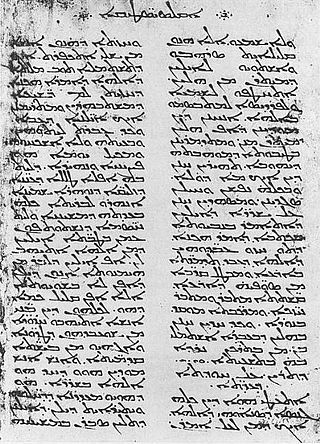Related Research Articles

The Peshitta is the standard version of the Bible for churches in the Syriac tradition, including the Maronite Church, the Chaldean Catholic Church, the Syriac Catholic Church, the Syriac Orthodox Church, the Malabar Independent Syrian Church, the Syro-Malankara Catholic Church, the Mar Thoma Syrian Church, the Assyrian Church of the East and the Syro-Malabar Church.

Syriac is a dialect of Aramaic. Portions of the Old Testament were written in Aramaic and there are Aramaic phrases in the New Testament. Syriac translations of the New Testament were among the first and date from the 2nd century. The whole Bible was translated by the 5th century. Besides Syriac, there are Bible translations into other Aramaic dialects.
Codex Phillipps 1388, Syriac manuscript of the New Testament, on parchment. It contains the text of the four Gospels. Palaeographically it had been assigned to the 5th/6th centuries. It is one of the oldest manuscripts of Peshitta with some Old Syriac readings.
British Library, Add MS 14479, is a Syriac manuscript of the New Testament, on parchment. It is dated by a colophon to the year 534. It is one of the oldest manuscript of Peshitta and the earliest dated Peshitta Apostolos.
British Library, Add MS 14455 is a Syriac manuscript of the New Testament, on parchment. Palaeographically it has been assigned to the 6th century. It is a manuscript of the Peshitta. The manuscript is very lacunose.
British Library, Add MS 12140 is a Syriac manuscript of the New Testament, on parchment. Palaeographically it had been assigned to the 6th century. It is a manuscript of Peshitta. The manuscript is a lacunose.
British Library, Add MS 14466 is a Syriac manuscript of the New Testament, according to Peshitta version, on parchment. Palaeographically it has been assigned to the 10 or 11th century.
British Library, Add MS 14467, is a Syriac manuscript of the New Testament, according to the Peshitta version, on parchment. Palaeographic analysis has dated the manuscript to the 10th century.
British Library, Add MS 14669, Syriac manuscript of the New Testament, according to the Peshitta version, on parchment. Palaeographically it has been assigned to the 6th century. It contains fragments of the Gospels.
British Library, Add MS 14470, Syriac manuscript of the New Testament, on parchment. Palaeographically it has been assigned to the 5th or 6th century. It is one of the oldest manuscript of Peshitta with complete text of the New Testament.
British Library, Add MS 14448, designated by number 64 on the list of Wright, is a Syriac manuscript of the New Testament, on parchment, according to the Peshitta version. It is dated by a Colophon to the year 699 or 700. The manuscript is a lacunose. Gregory labelled it by 14e, 9a, and 8p . The codex is in the British Library as Add MS 14448.
British Library, Add MS 14453, designated by number 66 on the list of Wright, is a Syriac manuscript of the New Testament, on parchment, according to the Peshitta version. Palaeographically it has been assigned to the 5th or 6th century. The manuscript is lacunose. Gregory labelled it by 15e.

National Library of Russia, Codex Syriac 1, designated by siglum A, is a manuscript of Syriac version of the Eusebian Ecclesiastical History. It is dated by a Colophon to the year 462. The manuscript is lacunose.
British Library, Add MS 17124, designated by number 65 on the list of Wright, is a Syriac manuscript of the New Testament, according to Peshitta version, on parchment. Palaeographically it has been assigned to the 10th century. The manuscript is lacunose.
British Library, Add MS 12137, designated by number 75 on the list of Wright, is a Syriac manuscript of the New Testament, according to Peshitta version, on parchment. Palaeographically it has been assigned to the 6th or 7th century.
British Library, Add MS 14449, designated by number 69 on the list of Wright, is a Syriac manuscript of the New Testament, according to the Peshitta version, on parchment. Palaeographically it has been assigned to the 6th or 7th century.
British Library, Add MS 14457, designated by number 70 on the list of Wright, is a Syriac manuscript of the New Testament, according to the Peshitta version, on parchment. Palaeographically it has been assigned to the 6th or 7th century.
British Library, Add MS 14454, designated by number 87 on the list of Wright, is a Syriac manuscript of the New Testament, according to the Peshitta version, on parchment. Palaeographically it has been assigned to the 6th or 7th century.
British Library, Add MS 14462, designated by number 92 on the list of Wright, is a Syriac manuscript of the New Testament, according to the Peshitta version, on parchment. Palaeographically it has been assigned to the 6th century.
British Library, Add MS 17122, designated by number 137 on the list of Wright, is a Syriac manuscript of the New Testament, according to Peshitta version, on parchment. Palaeographically it has been assigned to the 6th century. The manuscript is lacunose.
References
- 1 2 3 Bruce M. Metzger, The Early Versions of the New Testament: Their Origin, Transmission and Limitations (Oxford University Press 1977), p. 51.
- 1 2 3 Bruce M. Metzger, The Early Versions of the New Testament: Their Origin, Transmission and Limitations (Oxford University Press 1977), p. 50.
- ↑ G. H. Gwilliam, Studia Biblica et eccles, Vol. 1, Oxford 1855, pp. 151-171
- ↑ Scrivener, Frederick Henry Ambrose; Edward Miller (1894). A Plain Introduction to the Criticism of the New Testament, Vol. 2 . London: George Bell & Sons. p. 12.
- 1 2 3 William Wright, Catalogue of the Syriac manuscripts in the British Museum (2002), p. 67.
- 1 2 Gregory, Caspar René (1902). Textkritik des Neuen Testaments. Vol. 2. Leipzig. p. 512.